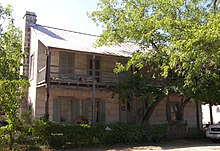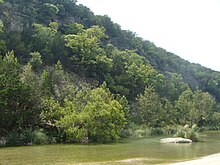Bandera County
![The Bandera County Courthouse and Jail in Bandera, listed in the NRHP with the number 79002911 [1]](https://upload.wikimedia.org/wikipedia/commons/thumb/3/3c/Bandera_county_courthouse.jpg/298px-Bandera_county_courthouse.jpg) The Bandera County Courthouse and Jail in Bandera, listed on the NRHP with number 79002911 |
|
| administration | |
|---|---|
| US state : | Texas |
| Administrative headquarters : | Bandera |
| Address of the administrative headquarters: |
Bandera County Courthouse P.O. Box 823 Bandera, TX 78003 |
| Foundation : | March 10, 1856 |
| Made up from: | Bexar County |
| Area code : | 001 830 |
| Demographics | |
| Residents : | 20,485 (2010) |
| Population density : | 10 inhabitants / km 2 |
| geography | |
| Total area : | 2066 km² |
| Water surface : | 15 km² |
| map | |
| Website : www.banderacounty.org | |
The Bandera County is a county in the state of Texas of the United States . The county seat is in Bandera .
geography
The county is located south of central Texas and has an area of 2066 square kilometers, of which 15 square kilometers are water. The Sabinal River flows to the west and the Medina River to the east . The county is bordered by counties in a clockwise direction: Kerr County , Kendall County , Bexar County , Medina County , Uvalde County, and Real County .
history
Bandera County was formed on January 25, 1856 from parts of Bexar County . It was named either after the Bandera Pass , named after the Spanish word for flag or after a Spanish general named Bandera, or the Bandera Mountains .
Archaeological finds confirm that the area was first settled around 10,000 years ago. The Apaches and later the Comanches settled here in the 18th century. In March 1854, a group of Mormons led by Lyman Wight arrived in the county. This group of about 250 members settled on the site of what is now Medina Lake . Because Wight died before the colony was completed, most Mormons moved on to Utah . In February 1855 a group of 16 Polish families arrived in the area, and in the same year the first general store and the first post office opened. The first two public schools opened in 1857 and 1858, and in 1860 the population had risen to 399 people. The population increased slowly and in 1870 there were already 649 people living here. The highest population figure was reached in 1900 with 5,332 inhabitants and fell steadily over the next 50 years.
From 1900 goat and sheep breeding was the largest source of income. In 1930 around 130,000 goats and 90,000 sheep and only 7,700 cattle were reported. In the same year 470,000 pounds of mohair wool and 589,000 pounds of virgin wool were produced.
Three buildings in the county are listed on the National Register of Historic Places (NRHP) (as of September 21, 2018).
Demographic data
| growth of population | |||
|---|---|---|---|
| Census | Residents | ± in% | |
| 1860 | 399 | - | |
| 1870 | 649 | 62.7% | |
| 1880 | 2158 | 232.5% | |
| 1890 | 3795 | 75.9% | |
| 1900 | 5332 | 40.5% | |
| 1910 | 4921 | -7.7% | |
| 1920 | 4001 | -18.7% | |
| 1930 | 3784 | -5.4% | |
| 1940 | 4234 | 11.9% | |
| 1950 | 4410 | 4.2% | |
| 1960 | 3892 | -11.7% | |
| 1970 | 4747 | 22% | |
| 1980 | 7084 | 49.2% | |
| 1990 | 10,562 | 49.1% | |
| 2000 | 17,645 | 67.1% | |
| 2010 | 20,485 | 16.1% | |
| For all years | |||

As of the 2000 census , Bandera County had 17,645 people in 7,010 households and 5,061 families. The population density was 9 people per square kilometer. The racial the population was composed of 94.02 percent white, 0.33 percent African American, 0.90 percent Native American, 0.28 percent Asian, 0.06 percent of residents from the Pacific island area and 2.55 percent from other ethnic groups Groups; 1.86 percent were descended from two or more races. 13.51 percent of the population were Hispanic or Latino of any race.
Of the 7,010 households, 29.1 percent had children or adolescents living with them. 60.8 percent were married couples living together, 7.3 percent were single mothers and 27.8 percent were non-families. 23.2 percent were single households and 9.9 percent had people aged 65 years or over. The average household size was 2.49 and the average family size was 2.92 people.
24.7 percent of the population was under 18 years old, 5.8 percent between 18 and 24, 25.7 percent between 25 and 44, 27.6 percent between 45 and 64 and 16.2 percent were 65 years of age or older. The median age was 41 years. For every 100 females there were 99 males and for every 100 females age 18 or over there were 98.3 males.
The median income for a household in the city is $ 39,013 , and the median income for a family is $ 45,906. Males had a median income of $ 31,733 versus $ 24,451 for females. The per capita income was $ 19,635. 7.7 percent of families and 10.8 percent of the population lived below the poverty line.
Places in the county
Protected areas and parks
- Bandera County Park
- Bear Springs Blossom Nature Preserve
- Hill Country State Natural Area
- Lost Maples State Natural Area
See also
Individual evidence
- ↑ a b c Excerpt from the National Register of Historic Places . Retrieved March 13, 2011
- ^ Bandera County in the United States Geological Survey's Geographic Names Information System . Retrieved February 22, 2011
- ↑ Information from the National Association of Counties ( Memento of the original dated April 2, 2012 in the Internet Archive ) Info: The archive link was inserted automatically and has not yet been checked. Please check the original and archive link according to the instructions and then remove this notice. . Retrieved October 10, 2012
- ↑ Charles Curry Aiken, Joseph Nathan Kane: The American Counties: Origins of County Names, Dates of Creation, Area, and Population Data, 1950-2010 . 6th edition. Scarecrow Press, Lanham 2013, ISBN 978-0-8108-8762-6 , p. 15 .
- ↑ Search mask database in the National Register Information System. National Park Service , accessed September 21, 2018.
- ↑ Texas Almanac: Population History of Countys from 1850–2010 (PDF; 698 kB), accessed September 18, 2012
- ^ Bandera County, Texas , 2000 census datasheet at factfinder.census.gov .
Web links
- Bandera County in Handbook of Texas (Engl.)
- "Bandera County profiles" of the Texas Association of Counties (Engl.)
Coordinates: 29 ° 44 ′ N , 99 ° 14 ′ W



